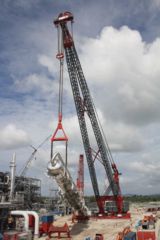Parts of Southeast Bangkok sinking by up to 28mm a year, seminar told
Due to extensive use of groundwater, land subsidence in Bangkok has reached a worrying level with instances more than doubling in neighbouring Samut Prakan, a seaside province, which is also losing land at an unusually high rate to coastal erosion, a Chulalongkorn University seminar was told yesterday.
Assoc Prof Itthi Trisirisattayawong, of the Faculty of Engineering, said the average sudsidence rate in Samut Prakan was around 10mm a year, but had reached 20.1mm, and even 28mm in areas connected to Thepharak and Srinakarin roads, and in the western parts of Bang Phli and Bang Bo districts.
In the north of Bangkok, areas along the Rangsit-Nakhon Nayok Road and branches of the Rangsit-Nakhon Nayok Canal in neighbouring Pathum Thani also faced subsidence of around 20-30mm per year – almost double the rate a decade ago. In neighbouring Samut Sakhon southwest of Bangkok, Itthi said affected areas included Om Noi, Omnai and – next to those areas – the Bangkok district of Nong Khaem.
There is no information on how the continued use of groundwater will affect the problem of subsidence in the long term. However, Itthi said a US study had found that subsidence in an unspecified valley had reached nine metres over a 50-year period.
Anek Suksamran, a local politician in Samut Prakan who attended the seminar, said that in six years, coastal erosion could eventually reach Sukhumvit Road – the region’s coastal road – which is currently a few hundreds metres from the coastline.
‘Too many houses’
Ithi said the rapid growth of housing estates in Bangkok’s suburbs and the expansion of small businesses relying on groundwater was aggravating the problem. Groundwater was easy to access and there were no laws against using it, he added.
Despite certain government controls over the use of groundwater, factors such as urban development and the building of high-rises and large-sized structures, such as bridges and expressways, were contributing to the problem of land subsidence in Bangkok, Itthi said.
However, he said there was no scientific research that could be used to estimate how far Bangkok would sink over the next 50 to 100 years.
“The control and state-sanctioned use of groundwater is the key to the pace at which land subsidence in Bangkok will occur,” he said.
THE NATION
